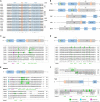Posttranslational Modifications in Conserved Transcription Factors: A Survey of the TALE-Homeodomain Superclass in Human and Mouse
- PMID: 33768097
- PMCID: PMC7985065
- DOI: 10.3389/fcell.2021.648765
Posttranslational Modifications in Conserved Transcription Factors: A Survey of the TALE-Homeodomain Superclass in Human and Mouse
Abstract
Transcription factors (TFs) guide effector proteins like chromatin-modifying or -remodeling enzymes to distinct sites in the genome and thereby fulfill important early steps in translating the genome's sequence information into the production of proteins or functional RNAs. TFs of the same family are often highly conserved in evolution, raising the question of how proteins with seemingly similar structure and DNA-binding properties can exert physiologically distinct functions or respond to context-specific extracellular cues. A good example is the TALE superclass of homeodomain-containing proteins. All TALE-homeodomain proteins share a characteristic, 63-amino acid long homeodomain and bind to similar sequence motifs. Yet, they frequently fulfill non-redundant functions even in domains of co-expression and are subject to regulation by different signaling pathways. Here we provide an overview of posttranslational modifications that are associated with murine and human TALE-homeodomain proteins and discuss their possible importance for the biology of these TFs.
Keywords: IRX; MEIS; PBX; PREP/PKNOX; PTM; TGIF; homeodomain protein; protein phosphorylation.
Copyright © 2021 Reichlmeir, Elias and Schulte.
Conflict of interest statement
The authors declare that the research was conducted in the absence of any commercial or financial relationships that could be construed as a potential conflict of interest.
Figures

Similar articles
-
HOXA1 and TALE proteins display cross-regulatory interactions and form a combinatorial binding code on HOXA1 targets.Genome Res. 2017 Sep;27(9):1501-1512. doi: 10.1101/gr.219386.116. Epub 2017 Aug 7. Genome Res. 2017. PMID: 28784834 Free PMC article.
-
Comprehensive analysis of animal TALE homeobox genes: new conserved motifs and cases of accelerated evolution.J Mol Evol. 2007 Aug;65(2):137-53. doi: 10.1007/s00239-006-0023-0. Epub 2007 Jul 30. J Mol Evol. 2007. PMID: 17665086
-
Range of HOX/TALE superclass associations and protein domain requirements for HOXA13:MEIS interaction.Dev Biol. 2005 Jan 15;277(2):457-71. doi: 10.1016/j.ydbio.2004.10.004. Dev Biol. 2005. PMID: 15617687
-
TALE transcription factors: Cofactors no more.Semin Cell Dev Biol. 2024 Jan-Feb;152-153:76-84. doi: 10.1016/j.semcdb.2022.11.015. Epub 2022 Dec 9. Semin Cell Dev Biol. 2024. PMID: 36509674 Review.
-
Hox cofactors in vertebrate development.Dev Biol. 2006 Mar 15;291(2):193-206. doi: 10.1016/j.ydbio.2005.10.032. Epub 2006 Mar 3. Dev Biol. 2006. PMID: 16515781 Review.
Cited by
-
The neuronal transcription factor MEIS2 is a calpain-2 protease target.J Cell Sci. 2024 Feb 15;137(4):jcs261482. doi: 10.1242/jcs.261482. Epub 2024 Feb 28. J Cell Sci. 2024. PMID: 38305737 Free PMC article.
-
PBX4 functions as a potential novel oncopromoter in colorectal cancer: a comprehensive analysis of the PBX gene family.Am J Cancer Res. 2022 Feb 15;12(2):585-600. eCollection 2022. Am J Cancer Res. 2022. PMID: 35261789 Free PMC article.
-
Comprehensive summary: the role of PBX1 in development and cancers.Front Cell Dev Biol. 2024 Jul 26;12:1442052. doi: 10.3389/fcell.2024.1442052. eCollection 2024. Front Cell Dev Biol. 2024. PMID: 39129784 Free PMC article. Review.
References
Publication types
LinkOut - more resources
Full Text Sources
Other Literature Sources
Miscellaneous

